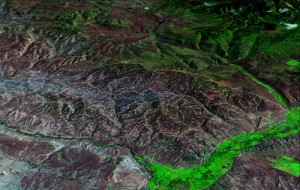Curtin University petroleum engineering researchers are using a high-speed drilling simulator to replicate the industry method of drilling deep boreholes in tight gas formations and shales.

Image credit: flickr User: SkyTruth
According to the media release by Curtin University, the drilling simulator has been designed with a drilling lid mounted on a True Triaxial Stress Cell (TTSC), which is capable of simulating at typical bottom hole conditions.
Professor Vamegh Rasouli of Curtin’s Department of Petroleum Engineering said the aim of the research was to improve efficiency in hard rock drilling, but also for shale gas drilling and fracturing.
According to him, the simulator was capable of performing normal, over-balanced and under-balanced drilling, as well as simulating the use of different mud types and drilling through hard rock with diamond-impregnated bits.
“Simulation of drilling practices in the laboratory will be very beneficial for field operations as we can study the effects of different parameters on drilling efficiency,” Professor Rasouli said.
“There are various issues to overcome during the drilling and production phases of gas wells, including wellbore instability during drilling and hydraulic fracturing for enhanced recovery.”
The TTSC has been used in hydraulic fracturing experiments on samples as small as 50 millimeters to understand the response of tight sandstones and gas shale formations to drilling.
Professor Rasouli said the TTSC has the ability to monitor the magnitude of stress and strains on the sample and measure torque ad drag systems, two important drilling operation parameters.
“During testing, three independent stresses can be applied to the sample to simulate real in-situ fieldstress conditions,” Professor Rasouli said.
“A significant feature of the rig is its ultra-high speed rotation which can move at up to 10,000 revolutions per minute (rpm) to simulate hard rock drilling in tight sandstones. A drilling fluid of any type can be circulated in the simulated borehole, similar to a field situation, to study its effect on drilling performance.”
Curtin researchers have observed that drill speeds above 5,000 rpm can improve the rate of penetration by using water pressure to fracture the rock, rather than direct contact. Curtin University confirmed that their research teams will further investigate this aspect of the simulation.


















